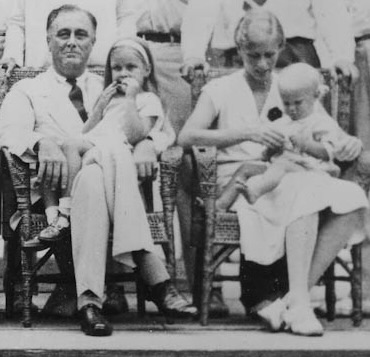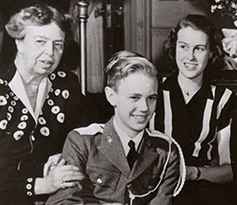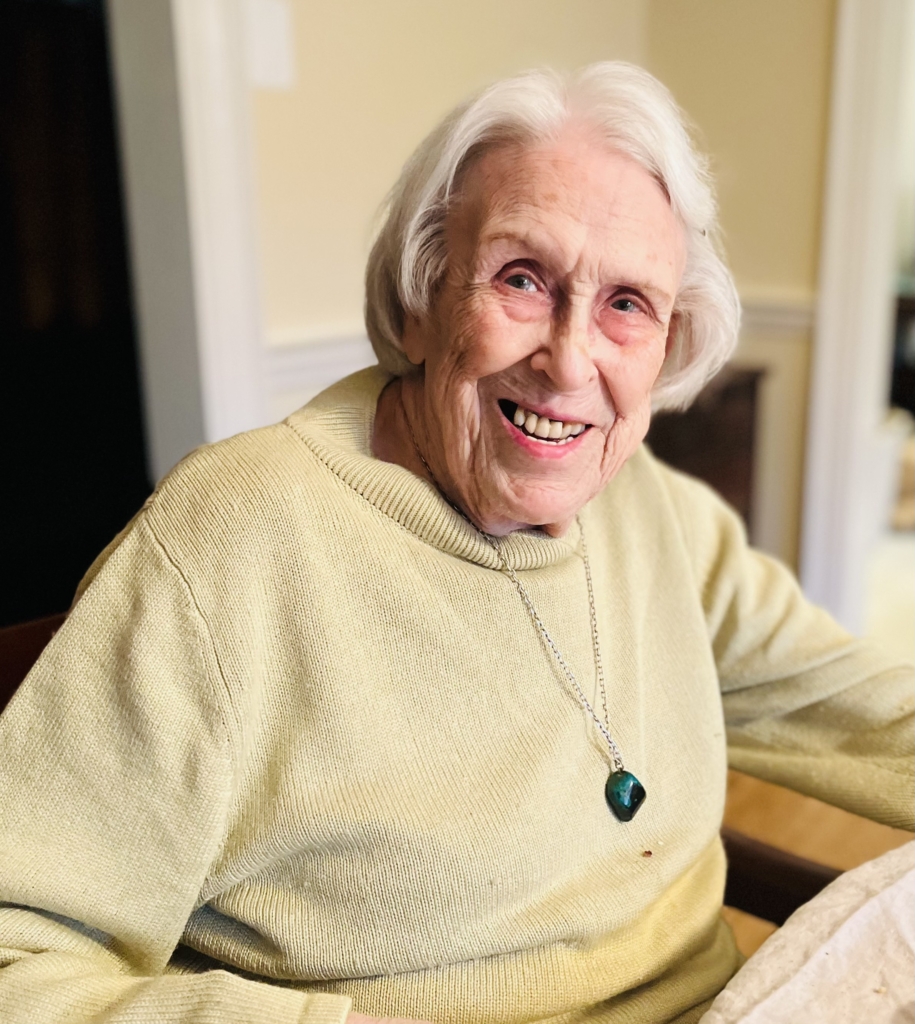Since 2005, when The Living New Deal began the work of documenting the New Deal’s achievements across the country, we’ve been fortunate to have members of the Roosevelt family on our team. Descendants of FDR and First Lady Eleanor Roosevelt have advised and supported our organization from the start. Several have served on the Living New Deal’s Advisory Board, which has afforded us opportunities to get to know other members of this accomplished family.
Recently we had the opportunity to talk with Anna Eleanor (Ellie) Roosevelt Seagraves. Ellie’s mother, Anna Roosevelt Dall, was the eldest of Franklin and Eleanor’s five children. Anna and her children Ellie and Curtis moved to the White House when the Dall’s divorced, and lived there from 1933 to 1935.
Anna remarried and returned to the White House in 1944 with her 5-year-old son, John Boettiger, to assist the President as his secretary and aide-de-camp. Now 96, Ellie lives in Bethesda, Maryland, where she spoke with Kurt Feichtmeir about growing up during the New Deal and her famous family.

KF:
You and your brother Curtis were very young when you moved to the White House in 1933. What do you remember about living under that historic roof?
My brother Curtis, whom I called Buzz, was only three and I was six when we moved to the White House. We had a lot of fun together. We were not always closely supervised and were never punished by the staff. I was the more mischievous. I remember one time we let a roll of toilet paper unroll all the way down a long staircase. Buzz loved cars, motorcycles, and the excitement of living in the White House. I was more practical and paid more attention to my mother and grandmother.
After your mother remarried and you moved out of the White House, did you return to visit your grandparents?
Our family moved to Seattle when I was ten, and every few years thereafter, we would take the train east, packing homework, for a Christmas month at the White House. We also spent a month in Hyde Park every few summers.
What was it like being in the midst of political family?
Of course, by 13 plus, one is more aware of the swirl of activity in the White House, and of the positions of the people one might meet there or at Hyde Park. I talked with many guests, by myself or along with family members, usually in casual conversation. Liberal values and humor were natural and it was always instructive to listen to the experiences of other people. I suppose that many folks were gentle with a young person like me and maybe they enjoyed recalling their own youth for a minute or two!
You and Curtis joined your grandfather at the 1937 dedication of Timberline Lodge in Oregon. Do you remember that event?
I do remember being there for the dedication. A photograph of Buzz sitting next to our grandfather (we called him PaPa) makes that memory real, even though I wasn’t in the picture. I later visited Timberline Lodge several times – a wonderful place.
What are some childhood memories of your grandfather?
I was very fond of my grandfather. He was wonderful with us. When Buzz and I lived in the White House he would spend several minutes with us each morning, reading to us and asking about our plans for the day as he had his breakfast in bed. I remember three or four grandkids gathered round to hear PaPa read a segment from Dickens’ “A Christmas Carol” on public radio.

As a young member of a high-profile family, where did you find your moral compass?
As the first grandchildren in our generation (there were 13 of us prior to FDR’s death in 1945), we learned early on the social and moral values that are important in life; that one should respect others’ rights, be curious about events, be open-minded and empathetic, intolerant of cruelty and bigotry.
My brother Buzz and I attended St. James Episcopal Church when visiting Hyde Park, accompanying our grandparents or great-grandmother, Sara.
Home in Mercer Island, now a suburb of Seattle, our family did not attend church. Sundays were quiet times for my parents, away from the crowds and bustle of the work week; a time to catch up, go for walks, play board games, have conversations.
My mother had many roles: she was a working newspaper woman, directing womens’ pages production; she cared for her family; and she managed the household – plus carrying out obligations and requests, private and public, as “the president’s daughter.” She received and answered lots of mail. And still, she maintained her good nature!
She worked so hard in her life to steady her second and third marriages. She modeled how to carry her social load (and role) and still remain a person of good humor. The values of my grandparents and my mother, plus her good humor over some personal trials, stayed with me and with my husband Van and our three kids.
You had an especially close relationship with your grandmother. What were some of the lessons you absorbed from her?
When I was young, women were in charge of children. My mother and grandmother (we called her Grandmère) wanted me to know that there was a larger world outside the White House. I came to understand that the world didn’t revolve around me.
One time, my grandmother took Buzz and me on a drive to look at the housing on Capitol Hill, which at the time was quite dilapidated (it’s a fashionable neighborhood today.) I was used to living in nice big houses, like the one in Hyde Park, so seeing those run-down houses made an impression on me. It was only as a teenager that I realized what an important place the White House was to live in.
When Grandmère became First Lady, she made sure that employment was found for many existing white staff members and then replaced them with Black staff members. She wanted to demonstrate that Black people needed to be given a fair shake.
I always had wonderful relations with the White House staff and understood they were in charge.
In contrast, the staff members at Hyde Park were White. When the long-serving English butler learned that Black staff from the White House would be coming to assist with the 1939 visit of the King and Queen of England, he quit in protest.
By 1933, in the White House, Grandmère not only changed many in the house staff, but in her news conferences, she requested that female, not male, reporters be admitted. Until that time most First Ladies didn’t have news conferences and the President’s conferences with reporters were male only.
Did you two remain close throughout her life?
Grandmère was generous and helped me at different times in my life.
The first place Van and I lived after we got married was a one-room apartment with a pull-down bed in downtown Portland, Oregon. Grandmère came to visit us on one of her trips to the Northwest. When she saw our living situation, she decided we needed a more suitable home and helped us purchase our first house.
In 1958, Grandmère funded a trip for me to Israel where I met my mother and her third husband, Dr. James Halsted, before accompanying them to Shiraz, Iran, where Halsted was doing nutritional research at the medical university.
She was a very good grandmother and an amazing person!
Can you tell us a bit about your time at Hyde Park?
When we moved to Seattle, I didn’t have babysitting jobs like other girls my age, probably because of the Secret Service security issues. In 1943 I turned 16, and that summer, before I went to boarding school in San Francisco, I spent 6 or 7 weeks in Hyde Park. My grandmother’s secretary “Tommy” [Malvina Thompson] put me to work typing correspondence, simple letters and thank you notes. It was my first paid job at 25¢ an hour – big money in those days! I enjoyed it and felt I was doing something important. I’d ride my uncle John’s horse to get across to my grandmother’s cottage, Val-Kill, where I’d spend the day. Another summer I helped catalog the collection of Grandmere’s books at Val-Kill.
Looking back, those jobs were a way to keep a teenager busy and out of trouble, but they also gave me the chance to do something useful and interesting.
You attended Reed College in Portland, Oregon.
A friend of my mother suggested Reed College, and I liked being there. I was a very shy teenager. I wasn’t talented academically or musically, and wasn’t good at sports. I didn’t want to be a star. At Reed, I thought about studying science, but when I realized I’d have to take statistics, I gave up that idea. In those days, the typical career choices for women were nurse, teacher, or librarian. I knew I wouldn’t be a good nurse, and the idea of managing a class of children intimidated me. That left librarian.
In my freshman year at Reed, there were very few young men, since they were away at the War. But in my sophomore year, guys came back. They had so much more life experience than us girls! That’s when I met my future husband, Van Seagraves, who had returned from the Navy.
Years later I returned to the idea of becoming a librarian. Van was working as a newspaperman in Rochester, and we had moved to upstate New York. I was a stay-at-home mother until our youngest was in kindergarten. I studied library science at the SUNY campus in Geneseo, New York and worked in school libraries.
Raising three children, managing the household, and working as a librarian must have been challenging.
I didn’t have to teach my kids “down to earth,” we simply were—money was paycheck to paycheck. Looking back now, in my 90s, I’ve had a good life for a person with no talent, and I’m grateful for my good fortune. I had a great husband who was a good father to our children. We were married for 70 years. There were so many divorces in the Roosevelt family. I wanted to set an example of making a good marriage the first time. Of course, I was uncertain about my marriage at first, as many people are, but I was lucky.
I’ve had good health, good luck, and I’ve made some good decisions.
Any closing thoughts?
I was pleased to see the Living New Deal recognized on the PBS NewsHour! Your organization is doing such important work to teach about the history of the New Deal. I think it’s really good news that you’ve hired a person who knows the arts fields. The visual arts, plus writing projects, seem to me of huge importance in the New Deal years.


Hi Kurt, Very nice interview ofEllie! Dan Shogren
What a treasure to hear this voice and insights of her original contact with world changing family members and history. Not many voices left. Thank you!
Wonderful feature! While reading Wikipedia I came across Ellie and followed the reference to this article. I love how she is a living historian who experienced many pivotal events of the mid 20th-century firsthand. Many things that she said in this interview ring true for my life in the early 21st-century. As an amateur historian, it’s such a treat to read stories of such long-lived historic figures. Best wishes to such a kind and accomplished woman.
I was so pleased to read your experience as a granddaughter of President Roosevelt and Eleanor. I have always been fascinated by President Roosevelt due to my parents admiration for him. They constantly talked about him and how grateful they were for the assistance he gave them and the country when everyone was struggling.